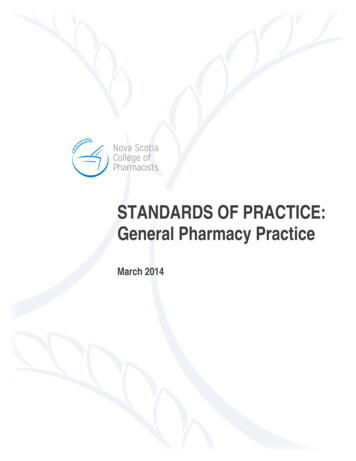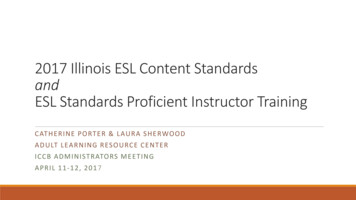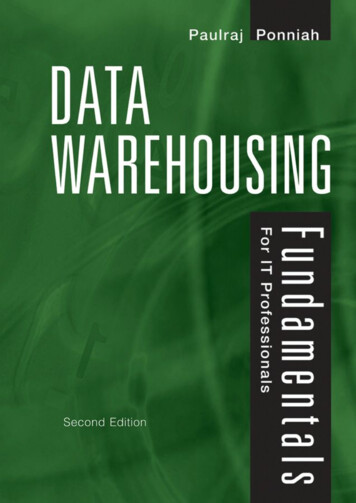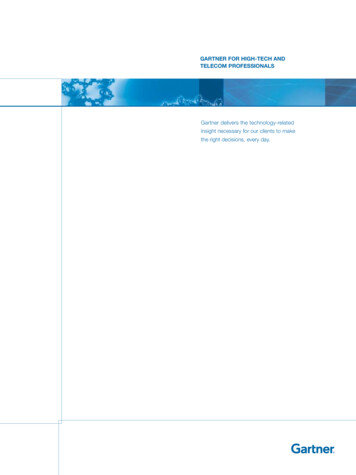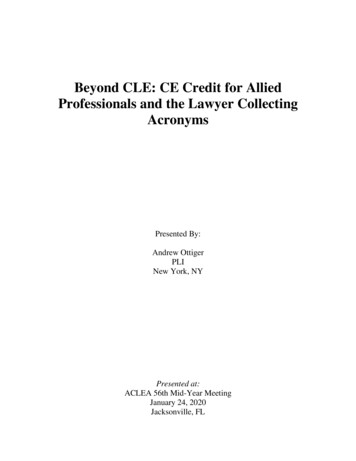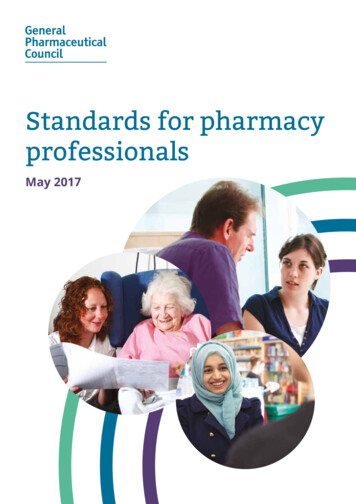
Transcription
Standards for pharmacyprofessionalsMay 2017
Standards for pharmacy professionalsMay 2017The text of this document (but not the logo and branding) may be reproduced free of charge in any format or medium,as long as it is reproduced accurately and not in a misleading context. This material must be acknowledged as GeneralPharmaceutical Council copyright and the document title specified. If we have quoted third party material, you mustget permission from the copyright holder.Contact us at communications@pharmacyregulation.org if you would like a copy of the document in anotherformat (for example, in larger type or in a different language). General Pharmaceutical Council 20172
About usThe General PharmaceuticalCouncil regulates pharmacists,pharmacy technicians and registeredpharmacies in Great Britain.What we doOur main work includes: setting standards for the education andtraining of pharmacists and pharmacytechnicians, and approving and accreditingtheir qualifications and training maintaining a register of pharmacists,pharmacy technicians and pharmacies setting the standards of conduct andperformance that pharmacy professionalshave to meet throughout their careers setting the standards of continuingprofessional development that pharmacyprofessionals have to achieve throughouttheir careers investigating concerns that pharmacyprofessionals are not meeting our standards,and taking action to restrict their ability topractise when this is necessary to protectpatients and the public setting standards for registered pharmacieswhich require them to provide a safe andeffective service to patients inspecting registered pharmacies to check ifthey are meeting our standards3
Standards for pharmacy professionalsMay 2017Introduction1 ‘Pharmacy professionals’ (pharmacistsand pharmacy technicians) play a vital rolein delivering care and helping people tomaintain and improve their health, safetyand wellbeing. The professionalism theydemonstrate is central to maintainingtrust and confidence in pharmacy.2 Patients and the public have a right to expectsafe and effective care from pharmacyprofessionals. We believe it is the attitudesand behaviours of pharmacy professionalsin their day-to-day work which make themost significant contributions to the qualityof care, of which safety is a vital part.3 The standards for pharmacy professionalsdescribe how safe and effective careis delivered through ‘person-centred’professionalism. The standards area statement of what people expectfrom pharmacy professionals,and also reflect what pharmacyprofessionals have told us they expectof themselves and their colleagues.4 At the heart of the standards is the principlethat every person must be treated as anindividual. Pharmacy professionals havean important role in involving, supportingand enabling people to make decisionsabout their health, safety and wellbeing.For example, what is important to oneperson managing their short or long-termcondition may not be important to another.4The standards forpharmacy professionals5 There are nine standards that everypharmacy professional is accountablefor meeting. The standards apply to allpharmacists and pharmacy technicians. Weknow that pharmacy professionals practisein a number of sectors and settings and mayuse different ways to communicate with thepeople they provide care to. The standardsapply whatever their form of practice. Andeven when pharmacy professionals do notprovide care directly to patients and thepublic, their practice can indirectly have animpact on the safe and effective care thatpatients and the public receive, and on theconfidence of members of the public inpharmacy as a whole.6 The standards need to be met at all times,not only during working hours. This isbecause the attitudes and behaviours ofprofessionals outside of work can affect thetrust and confidence of patients and thepublic in pharmacy professionals.7 The meaning of each of the standardsis explained, and there are examples ofthe types of attitudes and behavioursthat pharmacy professionals shoulddemonstrate. The examples may not applyin all situations.8 The standards include the term ‘personcentred care’ and refer to a ‘person’throughout. This means ‘the personreceiving care’. The term may also applyto carers or patients’ representativesdepending on the situation.
The standards andpharmacy studentsand traineesApplying the standards9 The standards for pharmacy professionalsare relevant to all pharmacy students andtrainees while they are on their journeytowards registration and practice. Thestandards explain the knowledge, attitudesand behaviours that will be expected ofstudents and trainees if they apply to jointhe register.14 We expect pharmacy professionals to considerthese standards, their legal duties and anyrelevant guidance when making decisions.10 They should be interpreted in the contextof education and training and used as atool to prepare students and trainees forregistration as a pharmacy professional.11 Pharmacy students and trainees shouldconsider the standards as they move closerto registration and professional practice, andshould read them alongside other relevantdocuments that are provided by initialeducation and training providers.The standardsand registration12 The standards are designed to reflect whatit means to be a pharmacy professional.They are also at the heart of initial educationand training, registration and renewal asa pharmacy professional, and continuingfitness to remain registered.13 Pharmacy professionals are personallyaccountable for meeting the standards andmust be able to justify the decisions they make.15 The standards and supporting explanationsdo not list the legal duties pharmacyprofessionals have, as all pharmacyprofessionals must keep to the relevant laws.Relevant guidance is published by a numberof organisations, including professionalleadership bodies, other regulators, theNHS, National Institute for Health and CareExcellence and Scottish IntercollegiateGuidelines Network, as well as by the GPhC.16 There will be times when pharmacyprofessionals are faced with conflicting legaland professional responsibilities. Or they maybe faced with complex situations that meanthey have to balance competing priorities.The standards provide a framework to helpthem when making professional judgements.Pharmacy professionals must work inpartnership with everyone involved, and makesure the person they are providing care to istheir first priority.5
Standards for pharmacy professionalsMay 2017Standardsfor pharmacyprofessionalsAll pharmacy professionals contributeto delivering and improving the health,safety and wellbeing of patients andthe public. Professionalism and safeand effective practice are central tothat role.Pharmacy professionals must:1 provide person-centred care2 work in partnership with others3 communicate effectively4 maintain, develop and use their professionalknowledge and skills5 use professional judgement6 behave in a professional manner7 respect and maintain the person’sconfidentiality and privacy8 speak up when they have concerns or whenthings go wrong9 demonstrate leadership6
LeadershipSpeakingup fe andeffective careConfidentialityand privacyProfessionalbehaviourEffective communicationProfessionalknowledgeand skillsProfessionaljudgement7
Standards for pharmacy professionalsMay 2017Standard 1:Pharmacy professionals must provideperson-centred careApplying the standardEvery person is an individual with their own values, needs and concerns. Person-centred careis delivered when pharmacy professionals understand what is important to the individual andthen adapt the care to meet their needs – making the care of the person their first priority. Allpharmacy professionals can demonstrate ‘person-centredness’, whether or not they provide caredirectly, by thinking about the impact their decisions have on people. There are a number of waysto meet this standard, and below are examples of the attitudes and behaviours expected.People receive safe and effective care when pharmacy professionals:8 obtain consent to provide care and pharmacy services involve, support and enable every person when making decisions about their health,care and wellbeing listen to the person and understand their needs and what matters to them give the person all relevant information in a way they can understand, so they can makeinformed decisions and choices consider the impact of their practice whether or not they provide care directly respect and safeguard the person’s dignity recognise and value diversity, and respect cultural differences – making sure that everyperson is treated fairly whatever their values and beliefs recognise their own values and beliefs but do not impose them on other people take responsibility for ensuring that person-centred care is not compromised because ofpersonal values and beliefs make the best use of the resources available
Standard 2:Pharmacy professionals must workin partnership with othersApplying the standardA person’s health, safety and wellbeing are dependent on pharmacy professionals working inpartnership with others, where everyone is contributing towards providing the person with the carethey need. This includes the person and will also include other healthcare professionals and teams.It may also include carers, relatives and professionals in other settings – such as social workers andpublic health officials. There are a number of ways to meet this standard and below are examples ofthe attitudes and behaviours expected.People receive safe and effective care whenpharmacy professionals: work with the person receiving care identify and work with the individuals and teamswho are involved in the person’s care contact, involve and work with the relevant localand national organisations demonstrate effective team working adapt their communication to bring abouteffective partnership working take action to safeguard people, particularlychildren and vulnerable adults make and use records of the care provided work with others to make sure there is continuity of carefor the person concerned9
Standards for pharmacy professionalsMay 2017Standard 3:Pharmacy professionals mustcommunicate effectivelyApplying the standardCommunication can take many forms and happens in different ways. Effective communication isessential to the delivery of person-centred care and to working in partnership with others. It helpspeople to be involved in decisions about their health, safety and wellbeing. Communication is morethan giving a person information, asking questions and listening. It is the exchange of informationbetween people. Body language, tone of voice and the words pharmacy professionals use allcontribute to effective communication. There are a number of ways to meet this standard andbelow are examples of the attitudes and behaviours expected.People receive safe and effective care when pharmacy professionals:10 adapt their communication to meet the needs of the person they are communicating with overcome barriers to communication ask questions and listen carefully to the responses, to understand the person’s needs andcome to a shared decision about the care they provide listen actively and respond to the information they receive in a timely manner check the person has understood the information they have been given communicate effectively with others involved in the care of the person
Standard 4:Pharmacy professionals must maintain, developand use their professional knowledge and skillsApplying the standardPeople receive safe and effective care when pharmacy professionals reflect on the application oftheir knowledge and skills and keep them up-to-date, including using evidence in their decisionmaking. A pharmacy professional’s knowledge and skills must develop over the course of theircareer to reflect the changing nature of healthcare, the population they provide care to and theroles they carry out. There are a number of ways to meet this standard and below are examples ofthe attitudes and behaviours expected.People receive safe and effective care when pharmacy professionals: recognise and work within the limits of their knowledge and skills, and refer to otherswhen needed use their skills and knowledge, including up-to-date evidence, to deliver care and improvethe quality of care they provide carry out a range of continuing professional development (CPD) activities relevant to theirpractice record their development activities to demonstrate that their knowledge and skills are upto date use a variety of methods to regularly monitor and reflect on their practice, skillsand knowledge11
Standards for pharmacy professionalsMay 2017Standard 5:Pharmacy professionals must usetheir professional judgementApplying the standardPeople expect pharmacy professionals to use their professional judgement so that they deliversafe and effective care. Professional judgement may include balancing the needs of individualswith the needs of society as a whole. It can also include managing complex legal and professionalresponsibilities and working with the person to understand and decide together what the rightthing is for them – particularly if those responsibilities appear to conflict. There are a number ofways to meet this standard and below are examples of the attitudes and behaviours expected.People receive safe and effective care when pharmacy professionals:12 make the care of the person their first concern and act in their best interests use their judgement to make clinical and professional decisions with the person or others have the information they need to provide appropriate care declare any personal or professional interests and manage these professionally practise only when fit to do so recognise the limits of their competence consider and manage appropriately any personal or organisational goals, incentives ortargets and make sure the care they pr
and pharmacy technicians) play a vital role in delivering care and helping people to maintain and improve their health, safety and wellbeing. The professionalism they demonstrate is central to maintaining trust and confidence in pharmacy. 2 Patients and the public have a right to expect safe and effective care from pharmacy professionals. We believe it is the attitudes and behaviours of .
